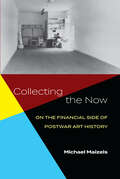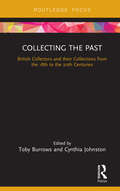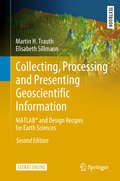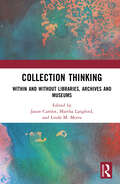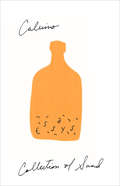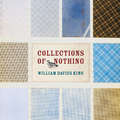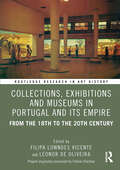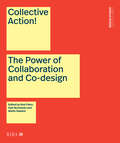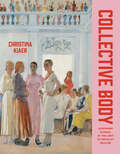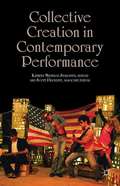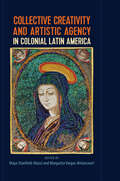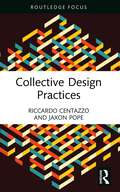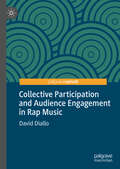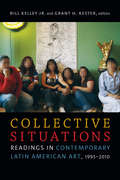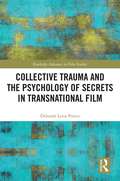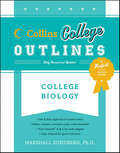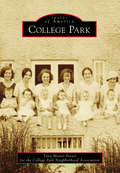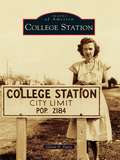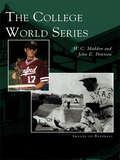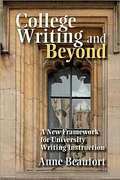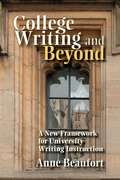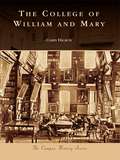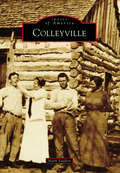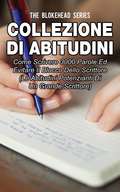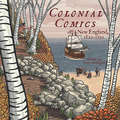- Table View
- List View
Collecting the Now: On the Financial Side of Postwar Art History
by Michael MaizelsCollecting the Now offers a new, in-depth look at the economic forces and institutional actors that have shaped the outlines of postwar art history, with a particular focus on American art, 1960–1990. Working through four case studies, Michael Maizels illuminates how a set of dealers and patrons conditioned the iconic developments of this period: the profusions of pop art, the quixotic impossibility of land art, the dissemination of new media, and the speculation-fueled neo-expressionist painting of the 1980s. This book addresses a question of pivotal importance to a swath of art history that has already received substantial scholarly investigation. We now have a clear, nuanced understanding of why certain evolutions took place: why pop artists exploded the delimited parameters of aesthetic modernism, why land artists further strove against the object form itself, and why artists returned to (neo-)traditional painting in the 1980s. But remarkably elided by extant scholarship has been the question of how. How did conditions coalesce around pop so that its artists entered into museum collections, and scholarly analyses, at pace unprecedented in the prior history of art? How, when seeking to transcend the delimited gallery object, were land artists able to create monumental (and by extension, monumentally expensive), interventions in the extreme wilds of the Western deserts? And how did the esoteric objects of media art come eventually to scholarly attention in the sustained absence of academic interest or a private market? The answers to these questions lie in an exploration of the financial conditions and funding mechanisms through which these works were created, advertised, distributed, and preserved.
Collecting the Past: British Collectors and their Collections from the 18th to the 20th Centuries (Routledge Research in Museum Studies)
by Toby Burrows Cynthia JohnstonToday’s libraries and museums are heavily indebted to the passions and obsessions of numerous individual collectors who devoted their lives to amassing collections of books, manuscripts, artworks, and other culturally significant objects. Collecting the Past brings together the latest research on a wide range of significant British collectors from the eighteenth to the twentieth centuries, including Hans Sloane, Sarah Sophia Banks, Thomas Phillipps, Sydney Cockerell, J. P. Morgan Jr., Alfred Chester Beatty and R. E. Hart. Contributors to the volume examine the phenomenon of collecting in a variety of settings and across a range of different materials. Considering the aims and motives that led these collectors to assemble such remarkable collections, the book also examines the history of these collections after the collector’s death. Particular attention is given to the often complicated relationship between collectors and the public institutions that subsequently came to house their collections. Situated within the framework of cultural collecting more generally, this book offers an authoritative series of essays on key collectors. Collecting the Past should be most interesting to researchers, academics and postgraduate students engaged in the study of museum studies, book history, manuscript studies, museum history, library history and the history of collecting. Professionals in libraries, museums and galleries will also find the volume of great interest.
Collecting, Processing and Presenting Geoscientific Information: How To Collect, Process And Present Geoscientific Information (Springer Textbooks in Earth Sciences, Geography and Environment)
by Martin H. Trauth Elisabeth SillmannThis second edition is an intensively revised and updated version of the book MATLAB® and Design Recipes for Earth Sciences. It aims to introduce students to the typical course followed by a data analysis project in earth sciences. A project usually involves searching relevant literature, reviewing and ranking published books and journal articles, extracting relevant information from the literature in the form of text, data, or graphs, searching and processing the relevant original data using MATLAB, and compiling and presenting the results as posters, abstracts, and oral presentations using graphics design software. The text of this book includes numerous examples on the use of internet resources, on the visualization of data with MATLAB, and on preparing scientific presentations. As with the book MATLAB Recipes for Earth Sciences–4rd Edition (2015), which demonstrates the use of statistical and numerical methods on earth science data, this book uses state-of-the art software packages, including MATLAB and the Adobe Creative Suite, to process and present geoscientific information collected during the course of an earth science project. The book's supplementary electronic material (available online through the publisher's website) includes color versions of all figures, recipes with all the MATLAB commands featured in the book, the example data, exported MATLAB graphics, and screenshots of the most important steps involved in processing the graphics.
Collection Thinking: Within and Without Libraries, Archives and Museums
by Linda M. Morra Jason Camlot Martha LangfordCollection Thinking is a volume of essays that thinks across and beyond critical frameworks from library, archival, and museum studies to understand the meaning of "collection" as an entity and as an act. It offers new models for understanding how collections have been imagined and defined, assembled, created, and used as cultural phenomena. Featuring over 70 illustrations and 21 original chapters that explore cases from a wide range of fields, including library and archival studies, literary studies, art history, media studies, sound studies, folklore studies, game studies, and education, Collection Thinking builds on the important scholarly works produced on the topic of the archive over the past two decades and contributes to ongoing debates on the historical status of memory institutions. The volume illustrates how the concept of "collection" bridges these institutional and structural categories, and generates discussions of cultural activities involving artifactual arrangement, preservation, curation, and circulation in both the private and the public spheres. Edited and introduced collaboratively by three senior scholars with expertise in the fields of literature, art history, archives, and museums, Collection Thinking is designed to stimulate interdisciplinary reflection and conversation. This book will be of interest to scholars and practitioners interested in how we organize materials for research across disciplines of the humanities and social sciences. With case studies that range from collecting Barbie dolls to medieval embroideries, and with contributions from practitioners on record collecting, the creation of sub-culture archives, and collection as artistic practice, this volume will appeal to anyone who has ever wondered about why and how collections are made.
Collection of Sand: Essays (Penguin Modern Classics Ser.)
by Italo CalvinoThis &“brilliant collection of essays&” and travelogues by the celebrated author of Invisible Cities &“may change the way you see the world around you&” (The Guardian, UK). Italo Calvino&’s boundless curiosity and ingenious imagination are displayed in peak form in Collection of Sand, his last collection of new works published during his lifetime. Delving into the delights of the visual world—both in art and travel—the subjects of these 38 essays range from cuneiform and antique maps to Mexican temples and Japanese gardens. In Calvino&’s words, this collection is &“a diary of travels, of course, but also of feelings, states of mind, moods…The fascination of a collection lies just as much in what it reveals as in what it conceals of the secret urge that led to its creation&” (from Collection of Sand). Never before translated into English, Collection of Sand is an incisive and often surprising meditation on observation and knowledge, &“beautifully translated by Martin McLaughlin&” (The Guardian, UK).
Collections of Nothing
by William Davies KingNearly everyone collects something, even those who don't think of themselves as collectors. William Davies King, on the other hand, has devoted decades to collecting nothing-- and a lot of it. Captivated by the detritus of everyday life, King has spent a lifetime gathering a monumental mass of miscellany, from cereal boxes to boulders to broken folding chairs. Junk, you might call it--and so might King, at times. With Collections of Nothing, he takes a hard look at this habitual hoarding to see what truths it can reveal about the impulse to accumulate. Part memoir, part reflection on the mania of acquisition, Collections of Nothing begins with the stamp collection that King was given as a boy. Philatelism's long-standing rules governing the care and display of collections soon proved an oppressive burden in the midst of the family chaos generated by his sister's growing mental illness; choosing to ignore the rules, King began to handle and display his collection according to his own desires-- the first step in his search for an unexplored, individual meaning in collecting. In the following years, rather than rarity or pedigree, he found himself searching out the lowly and the lost, the cast-off and the undesired: objects that, merely by gathering and retaining them, he could imbue with meaning, even value. As he relates the story of his burgeoning collections, King also offers a fascinating meditation on the human urge to collect. Whether it's nondescript loops of wire and old food labels or more commonly prized objects like first editions or baseball cards, our collections define us at least as much as we define them. This wry, funny, even touching appreciation and dissection of the collector's art as seen through the life of a most unusual specimen will appeal to anyone who has ever felt the unappeasable power of that acquisitive fever.
Collections, Exhibitions and Museums in Portugal and Its Empire: From the 18th to the 20th century (Routledge Research in Art History)
by Foteini VlachouFocusing on the period between the beginning of the eighteenth century and the late twentieth century, this edited volume examines the histories of objects, museums, exhibitions, and collections in Portugal or outside Portugal but representing Portugal, or related to it through colonial relationships.The book highlights the specificities of the Portuguese case, set against a globalised, transnational, and transcolonial context, and provides a precedent for future studies and a dialogue with equivalent studies related to other geographies. The diversity of the cultural, intellectual, and political contexts (imperial, colonial, monarchical, republican, authoritarian) offered by the Portuguese example allows for the exploration of a number of complex case-studies. Chapters study the artistic, collecting, and museological practices in Portugal and in the various geographical contexts of its colonial empire, with particular emphasis on the circulation and connectedness of objects, products, people, and ideas.The book will be of interest to scholars working in art history, museum studies, intellectual and cultural history, and imperial and colonial history.
Collective Action!: The Power of Collaboration and Co-Design in Architecture
by Kyle Buchanan Rob Fiehn Mellis HawardBuildings cannot be built without people working together. Architects collaborate with other disciplines, other architects and even with the public. These take place every day, across multiple planning and design stages. Small or emerging practices often suffer from a lack of resources, but what if we pooled our collective resources, sharing knowledge and experiences? Collaborative architecture begins in the design studio, and the relationship between academia and practice can create a symbiosis that is fundamental to the careers of young and more established architects. It provides a space to develop and test approaches outside of routine commercial pressures, using research to yield new approaches that further the impact of the architecture sector more widely. By cooperating, we can facilitate a good design process can lay the foundation for a better form of architecture that provides greater diversity and a plurality of voices. This volume showcases how practices have the potential to adapt, remain resilient and harness collective power to become greater than the sum of their parts. The future is bright for architects if they can unite. Take Collective Action! Features: Sarah Ahmed, Marc Cairns, Alasdair Ben Dixon, Amy Francis-Smith, Lanre Gbolade, Stephen Hill, Khuzema Hussain, Lacol, Matthew Morris, Chris Nasah, David Ogunmuyiwa, POoR Collective, Retrouvius, Dhruv Adam Sookhoo, Samuel Stair, Tomas Tvarijonas, Dr Joe Jack Williams, WIP Collaborative and Siri Zanelli.
Collective Body: Aleksandr Deineka at the Limit of Socialist Realism
by Christina KiaerA study of the Socialist Realist aesthetic focusing on the artist Aleksandr Deineka. Dislodging the avant-garde from its central position in the narrative of Soviet art, Collective Body presents painter Aleksandr Deineka’s haptic and corporeal version of Socialist Realist figuration as an alternate experimental aesthetic that, at its best, activates and organizes affective forces for collective ends. Christina Kiaer traces Deineka’s path from his avant-garde origins as the inventor of the proletarian body in illustrations for mass magazines after the revolution through his success as a state-sponsored painter of monumental, lyrical canvases during the Terror and beyond. In so doing, she demonstrates that Socialist Realism is best understood not as a totalitarian style but as a fiercely collective art system that organized art outside the market and formed part of the legacy of the revolutionary modernisms of the 1920s. Collective Body accounts for the way the art of the October Revolution continues to capture viewers’ imaginations by evoking the elation of collectivity, making viewers not just comprehend but truly feel socialism, and retaining the potential to inform our own art-into-life experiments within contemporary political art. Deineka figures in this study not as a singular master, in the spirit of a traditional monograph, but as a limit case of the system he inhabited and helped to create.
Collective Creation in Contemporary Performance
by Kathryn SyssoyevaThis edited volume situates its contemporary practice in the tradition which emerged at the beginning of the twentieth century. Collective Creation in Contemporary Performance examines collective and devised theatre practices internationally and demonstrates the prevalence, breadth, and significance of modern collective creation.
Collective Creativity and Artistic Agency in Colonial Latin America
by Maya Stanfield-Mazzi Margarita Vargas-BetancourtRethinking the role of the artist and recovering the work of unacknowledged creators in colonial society This volume addresses and expands the role of the artist in colonial Latin American society, featuring essays by specialists in the field that consider the ways society conceived of artists and the ways artists defined themselves. Broadening the range of ways that creativity can be understood, contributors show that artists functioned as political figures, activists, agents in commerce, definers of a canon, and revolutionaries. Chapters provide studies of artists in Peru, Mexico, and Cuba between the sixteenth and early nineteenth centuries. Instead of adopting the paradigm of individuals working alone to chart new artistic paths, contributors focus on human relationships, collaborations, and exchanges. The volume offers new perspectives on colonial artworks, some well known and others previously overlooked, including discussions of manuscript painting, featherwork, oil painting, sculpture, and mural painting. Most notably, the volume examines attitudes and policies related to race and ethnicity, exploring various ethnoracial dynamics of artists within their social contexts. Through a decolonial lens not often used in the art history of the era and region, Collective Creativity and Artistic Agency in Colonial Latin America examines artists’ engagement in society and their impact within it.Contributors: Derek S. Burdette | Ananda Cohen-Aponte | Emily C. Floyd | Aaron M. Hyman | Barbara E. Mundy | Linda Marie Rodriguez | Jennifer R. Saracino | Maya Stanfield-Mazzi | Margarita Vargas-Betancourt Publication of this work made possible by a Sustaining the Humanities through the American Rescue Plan grant from the National Endowment for the Humanities.
Collective Design Practices
by Riccardo Centazzo Jaxon PopeBy encouraging a critical evaluation of the contemporary processes of knowledge creation within design, Collective Design Practices aims to open perspectives and conversations on the immense possibilities thinking and acting collectively can have in work, education, culture, and life. Through the observation of past and present collectives of varying scales and geographies, and reflections on the implications of dialogue, generosity, and participation in non-hierarchical structures, this concise book provides a condensed exploration of how our relationships with identity, authorship, context, and each other can shape the way we work and think together, ultimately influencing our approaches to solving the increasingly complex issues of our futures. Bringing together reflection and critical discussion, and acknowledging the disconnection between design research and design practice, this short, accessible book provides both a point of contact to research and a point of access to practitioners interested in the possible trajectories of the extended design field.
Collective Participation and Audience Engagement in Rap Music (Pop Music, Culture and Identity)
by David DialloWhy do rap MCs present their studio recorded lyrics as “live and direct”? Why do they so insistently define abilities or actions, theirs or someone else’s, against a pre-existing signifier? This book examines the compositional practice of rap lyricists and offers compelling answers to these questions. Through a 40 year-span analysis of the music, it argues that whether through the privileging of chanted call-and-response phrases or through rhetorical strategies meant to assist in getting one’s listening audience open, the focus of the first rap MCs on community building and successful performer-audience cooperation has remained prevalent on rap records with lyrics and production techniques encouraging the listener to become physically and emotionally involved in recorded performances. Relating rap’s rhetorical strategy of posing inferences through intertextuality to early call-and-response routines and crowd-controlling techniques, this study emphasizes how the dynamic and collective elements from the stage performances and battles of the formative years of rap have remained relevant in the creative process behind this music. It contends that the customary use of identifiable references and similes by rap lyricists works as a fluid interchange designed to keep the listener involved in the performance. Like call-and-response in live performances, it involves a dynamic form of communication and places MCs in a position where they activate the shared knowledge of their audience, making sure that they “know what they mean,” thus transforming their mediated lyrics into a collective and engaging performance.
Collective Situations: Readings in Contemporary Latin American Art, 19952010
by Grant H. Kester Bill Kelley Jr. Jr.In Collective Situations scholars, artists, and art collectives present a range of socially engaged art practices that emerged in Latin America during the Pink Tide period, between 1995 and 2010. This volume's essays, interviews, and artist's statements—many of which are appearing in English for the first time—demonstrate the complex relationship between moments of political transformation and artistic production. Whether addressing human rights in Colombia, the politics of urban spaces in Brazil, the violent legacy of military dictatorships in the region, or art’s intersection with public policy, health, and the environment, the contributors outline the region’s long-standing tradition of challenging ideas about art and the social sphere through experimentation. Introducing English-language readers to some of the most dynamic and innovative contemporary art in Latin America, Collective Situations documents new possibilities for artistic practice, collaboration, and creativity in ways that have the capacity to foster vibrant forms of democratic citizenship. Contributors Gavin Adams, Mariola V. Alvarez, Gustavo Buntinx, María Fernanda Cartagena, David Gutiérrez Castañeda, Fabian Cereijido, Paloma Checa-Gismero, Kency Cornejo, Raquel de Anda, Bill Kelley Jr., Grant H. Kester, Suzanne Lacy, Ana Longoni, Rodrigo Martí, Elize Mazadiego, Annie Mendoza, Alberto Muenala, Prerana Reddy, Maria Reyes Franco, Pilar Riaño-Alcalá, Juan Carlos Rodríguez
Collective Trauma and the Psychology of Secrets in Transnational Film (Routledge Advances in Film Studies)
by Deborah Lynn PorterCollective Trauma and the Psychology of Secrets in Transnational Film advances a methodological line of inquiry based on a fresh insight into the ways in which cinematic meaning is generated and can be ascertained. Premised on a critical reading strategy informed by a metapsychology of secrets, the book features analyses of internationally acclaimed films—Guillermo del Torro’s Pan’s Labyrinth, Andrey Zvyagintsev’s The Return, Jee-woon Kim’s A Tale of Two Sisters, and Alejandro Amenábar’s The Others. It demonstrates how a rethinking of the figure of the secret in national film yields a new vantage point for examining heretofore unrecognized connections between collective historical experience, cinematic production and a transnational aesthetic of concealment and hiding.
College Biology (Collins College Outlines)
by Marshall SundbergThe Collins College Outline for College Biology is a comprehensive overview of core topics from cell structure to genetic engineering. Chapters on DNA and basic biological chemistry; animal development and major organ systems; plant structure and function; populations and ecosystems; current and controversial issues; and more will provide students with all of the information needed to master a college-level or AP biology course. Fully revised and updated by Dr. Marshall Sundberg, College Biology includes practical "test yourself" sections with answers and complete explanations at the end of each chapter. Also included are essential vocabulary definitions and sample exercises, as well as detailed images, charts, and diagrams.The Collins College Outlines are a completely revised, in-depth series of study guides for all areas of study, including the Humanities, Social Sciences, Mathematics, Science, Language, History, and Business. Featuring the most up-to-date information, each book is written by a seasoned professor in the field and focuses on a simplified and general overview of the subject for college students and, where appropriate, Advanced Placement students. Each Collins College Outline is fully integrated with the major curriculum for its subject and is a perfect supplement for any standard textbook.
College Park (Images of America)
by Tana Mosier Porter College Park Neighborhood AssociationCollege Park has the look and feel of small-town America, with its central business district and tree-lined residential streets, schools and churches, and strong sense of community. College Park, though, was never a town; it developed as a neighborhood within the city of Orlando. The name originated not with a college but instead with a developer, who gave the streets in his new subdivision college names in 1921. In 1925, another developer named the first of several subdivisions College Park. The name caught on and became official with the naming of the College Park Post Office in 1954. Images of America: College Park commemorates 90 years of its history and community. From the 19th-century citrus groves, to new subdivisions in the 1920s, to tract housing in the 1940s and 1950s, College Park evolved as a desirable place for families.
College Station
by Glenn D. DavisThe first land-grant college in Texas--called the Agricultural and Mechanical College--was predominantly a military school, built in 1876 in a then-remote area of Central Texas. Like other developments, the institute was a result of the expanding railroad, so a station named "College" was erected to service the new school. Drawing newcomers to the area, the city of College Station was incorporated in 1938, and its size soon rivaled that of neighboring Bryan--the Brazos County seat. The College Station area offers a surprisingly diverse mix of attractions, including the George Bush Presidential Library, the Texas Motor Speedway, and Kyle Field. During the last century, the college has grown from a few hundred students into a major university with more than 49,000 students, making Texas A&M the seventh-largest school in the nation. Today College Station is home to some 100,000 people.
College World Series, The (Images of Baseball)
by W. C. Madden John E. PetersonSince 1950, Omaha's Rosenblatt Stadium (formerly Municipal Stadium) has hosted the nation's top college baseball programs in the College World Series. Baseball fans from every corner of the country have taken the annual "Road to Omaha" and packed the seats to see championship baseball at its best. In 1954 thousands saw Jim Ehrler of Texas toss the tourney's first no-hitter en route to the Longhorns winning back-to-back CWS championships. Fans at the 1970 tournament saw Southern Cal defeat Florida State in the midst of their unmatched five-year championship run. In 1996 Rosenblatt's faithful took in the dramatic bottom-of-the-ninth, two-out, two-run homer by Louisiana State's Warren Morris, giving his team a 9-8 upset victory over powerhouse Miami.
College Writing and Beyond
by Anne BeaufortComposition research consistently demonstrates that the social context of writing determines the majority of conventions any writer must observe. Still, most universities organize the required first-year composition course as if there were an intuitive set of general writing "skills" usable across academic and work-world settings. In College Writing and Beyond: A New Framework for University Writing Instruction, Anne Beaufort reports on a longitudinal study comparing one student's experience in FYC, in history, in engineering, and in his post-college writing. Her data illuminate the struggle of college students to transfer what they learn about "general writing" from one context to another. Her findings suggest ultimately not that we must abolish FYC, but that we must go beyond even genre theory in reconceiving it. Accordingly, Beaufort would argue that the FYC course should abandon its hope to teach a sort of general academic discourse, and instead should systematically teach strategies of responding to contextual elements that impinge on the writing situation. Her data urge attention to issues of learning transfer, and to developmentally sound linkages in writing instruction within and across disciplines. Beaufort advocates special attention to discourse community theory, for its power to help students perceive and understand the context of writing.
College Writing and Beyond: A New Framework for University Writing Instruction
by Anne BeaufortComposition research consistently demonstrates that the social context of writing determines the majority of conventions any writer must observe. Still, most universities organize the required first-year composition course as if there were an intuitive set of general writing "skills" usable across academic and work-world settings. In College Writing and Beyond: A New Framework for University Writing Instruction, Anne Beaufort reports on a longitudinal study comparing one student’s experience in FYC, in history, in engineering, and in his post-college writing. Her data illuminate the struggle of college students to transfer what they learn about "general writing" from one context to another. Her findings suggest ultimately not that we must abolish FYC, but that we must go beyond even genre theory in reconceiving it. Accordingly, Beaufort would argue that the FYC course should abandon its hope to teach a sort of general academic discourse, and instead should systematically teach strategies of responding to contextual elements that impinge on the writing situation. Her data urge attention to issues of learning transfer, and to developmentally sound linkages in writing instruction within and across disciplines. Beaufort advocates special attention to discourse community theory, for its power to help students perceive and understand the context of writing.
College of William & Mary, The
by Chris DickonBy the time of the American Revolution, the College of William and Mary was already into its eighth decade as the academic source of what the new nation would become and how it would relate to the larger world. Its land had been surveyed by George Washington, and its first honorary degree had been given to Ben Franklin. It would go on to educate two signers of the Declaration of Independence, three American presidents, and three justices of the Supreme Court. Chartered by British royalty in 1693, the college retains that connection to its roots into the 21st century. Remarkably through history, the College of William and Mary was, and remains, a public university--one of 16 in the Commonwealth of Virginia. At a time in American history when the 18th-century thought and practice of Thomas Jefferson has become part of the contemporary conversation, the college from which he graduated in 1762 continues to pursue his simple notion that "worth and genius [be] sought from every condition of life."
Colleyville (Images of America)
by Mark FaddenRanked by multiple magazines, including Money and D Magazine, as one of the "Best Places to Live" in the United States, it is easy to forget where Colleyville came from. A rural farming outpost that started out as six different "parent communities," residents eventually banded together and incorporated to become Colleyville in 1956. While Colleyville is named for Dr. Lilburn Howard Colley, entire generations of Colleyville citizens have displayed his spirit of hard work, determination, and caring for this city. From a few clusters of pioneering families to a close-knit community known for its dairy farms and horse racing track to becoming one of the nation's premier cities, Colleyville's population has grown from about 1,500 in 1960 to more than 24,000 today.
Collezione di Abitudini: Come Scrivere 3000 Parole Ed Evitare Il Blocco Dello Scrittore
by The BlokeheadSe sei sempre stato attratto dalle parole, hai fervida immaginazione, e possiedi la capacità di trasformare le tue immagini mentali in parole, sei stato probabilmente attratto dalla scrittura, o hai tentato di scrivere, una o più volte nella tua vita. Ogni giorno vediamo i libri appena usciti sugli scaffali o e-book che diventano disponibili online, e siamo costretti a prendere in considerazione ciò che serve per trasformare il nostro modo con le parole in un vascello in grado di trasportarci verso la grandezza come autori. Scrittori efficaci, sia del passato sia dei giorni nostri, che hanno lasciato un segno letterario di profondità ed ispirazione sul mondo, hanno un modo di pensare che si differenzia dagli altri attorno a loro. Come chi è pieno di slancio creativo, i loro processi di pensiero possono sembrare un po’ “fuori”, ma è la loro accettazione di questo fatto e la loro volontà di abbracciare pubblicamente la propria psicologia che li ha portati dove sono oggi. Quindi, tu pensi come un individuo che ha il potenziale di essere uno scrittore di successo, uno che lascerà un segno permanente nei cuori e nelle menti di coloro che entrano nel tuo mondo scritto? Qui passeremo in rassegna il modo in cui i grandi scrittori pensano e il modo in cui processano e rispondono ai loro stessi pensieri, e mostreremo i parallelismi tra queste caratteristiche e i brillanti lavori che essi producono. Continua la lettura per scoprire dove ti trovi psicologicamente e come puoi far psicologicamente emergere pezzo per pezzo lo scrittore ricercato e di consistente successo che c’è in te.
Colonial Comics: New England: 1620 - 1750 (Colonial Comics)
by Jason RodriguezColonial Comics is a graphic novel collection of twenty stories focusing on the colonial period from 1620 through 1750 in New England. <P><P> Created in partnership with the Massachusetts Historical Society and the Concord Museum, these illustrated stories focus on tales you cannot find in history books. Includes stories about free thinkers, Pequots, Jewish settlers, female business owners and dedicated school teachers, whales and livestock, slavery and frontiers, and many other aspects of colonial life.Jason Rodriguez is a writer and editor whose books have been nominated for an Eisner Award and eight Harvey Awards. Jason lives in Arlington, Virginia, with his wife and their two dogs, four cats, and a parrot. You can usually find him on a street corner, staring out into the future. <P><P> <i>Advisory: Bookshare has learned that this book offers only partial accessibility. We have kept it in the collection because it is useful for some of our members. Benetech is actively working on projects to improve accessibility issues such as these.</i>
